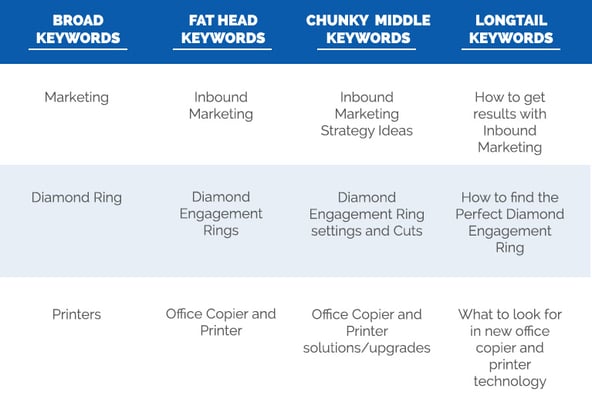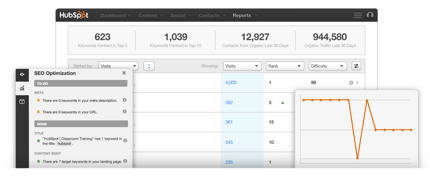This blog was also published on HubSpot's Marketing Blog.
When we talk inbound marketing, a big piece of that puzzle is SEO and content. At the center of those pieces are keywords. But when we’re putting together campaigns, strategies, and content calendars, we’re often asked, How can you tell people are using or searching for certain keywords? We’ve got a plethora of blogs on SEO and keywords – but nothing on this specific topic, hence this blog. And because I’m a “the more details the better” kind of girl – I’m going to take a few steps back and start at the beginning, so you’re equipped with as much knowledge as possible. Let’s do this ...
So, What is a Keyword?
Technically speaking, a keyword is “an informative word used in an information retrieval system to indicate content of a document.” Thanks, Google. Now, in English; a keyword – in HubSpot’s words – is most often, “a word or phrase that is a topic of significance.”
Seems pretty simple, right? It is – although there is something else you should note about keywords. There are four different kinds of keywords:
- Broad Keywords are shorter words – most often one word on its own. Although these keywords are easily applied to your industry or company, they are likely easily applied to many companies within your industry.
- Fat Head Keywords are similar to broad keywords but are usually made up of two or three general, broad keyword.
- Chunky Middle Keywords are where those keywords that are most competitive and least competitive cross over. Jabez LeBret describes them as the “keywords and phrases that real potential customers are typing into search engines everyday.”
- Long-Tail Keywords are typically longer phrases or a series of words that are a bit more specific to who you are – both your company and within your industry.
Here’s an example:

Ok, What is the Importance of Keywords?
Keywords are important because they’re the key (see what I did there?) to gaining insight into your potential customers’ – or your ideal buyer personas’ – questions, pain points, or interests. As searchers, your target audience uses keywords when they verbalize topics in the form of online searches as they seek more information.
Our trusty go-to inbound marketing resource, HubSpot, narrows down the answer to Why do I Need Keywords? to three simple reasons…
- Keywords = Content Foundation
Each page of content (or blog, or offer, or email) has a main topic, and that topic generally ties back to a keyword or keyword phrase. Keywords help establish the foundation of your content and give your visitors an understanding of the page.
- Keywords Give Purpose & Understanding
When reading information they find, visitors are quick to scan content for keywords or phrases they originally searched for. Keywords = gold, in this case.
- Keywords Help Search Engines
As search engines crawl your site, they index pages based on the keywords they find to help determine the purpose of the content.
As Wendy Boswell puts it, “Whether you're looking for just the right keywords to target in an article or site content, gauging what popular keyword searches are at any given moment, or getting a good idea of what future keyword searches might be, keyword search tools can help you accomplish all these goals and more.”
Six Ways to Figure out What Keywords People are Using
When it comes to figuring out what keywords potential buyers, clients, and customers are using, there’s a whole lot of due diligence to be done, and it’s something we take very seriously. Lucky for you, I’m here to loan you a few secret weapons so you can DIY, if need be. Below are a few tried and true ways to gain some insight into what keywords people are using.
1. Use Your People
Yes, your people. Who qualifies as “your people?” Your customers, potential buyers, staff, etc. Anyone who is familiar with your business, uses your product, purchases your goods… even those who choose a competitor – those are your people. So, ask questions and do some homework - what questions are they asking? What are ‘hot topics’ or trends? These notes will be big players in your keyword game.
When you’re doing this, be sure to remove yourselves from the process and put yourselves in your persona’s shoes – use the words and terms they use, ask questions in the way they ask them, etc. Oftentimes, the keywords a business thinks they should rank for or talk about are not the terms their customers are actually using.
2. Get Social
Don’t overlook your social media channels – especially when it comes to trying to figure out what your people are talking about, asking, or complaining about. Advancements and updates to social channels have brought with them a look into trending topics and more, including:
- Facebook
Facebook has made a whole lot of updates to their graph search tool, which allows you to search pretty much anything your connections might be talking about. Take a few minutes to learn more about Facebook Graph Search and how to best use it. They also have a Trending toolbar on the right side of their newsfeed that show popular topics, and the option to narrow into Politics, Science & Technology, Sports, and Entertainment.
- Twitter
Twitter actually has two different ways to get an inside look at what people are talking about. And the good news is, you don’t actually have to tweet yourself to see them (although you will need to follow others from an account.) On the left sidebar of Twitter’s homepage, you can see trending topics; these can be tailored based on location and interest. You can also use Twitter’s search functionality for trending topics, keywords, and hashtags.
- Google+
When you login to your Google+ account, you can head to the Trending page – similar to Facebook and Twitter – to see who is talking about what on Google+.
- YouTube
Like its social media platform friends, YouTube also has a Trends Dashboard – right here – that will show what the most popular videos and topics are. You can narrow in on these trends by selecting a city, state, or country, an age group, and gender. According to YouTube, “Trending Topics are algorithmically-generated topics from keywords in the title, tags, and description of the video within sets of videos that are currently rising in popularity. Trending videos are based on embedded video views and views on YouTube.”
3. HubSpot Keyword Grader

Ah, HubSpot… you’ve always got our back. And when it comes to keywords – there’s no disappointing here. HubSpot’s Keyword Grader allows users to get real time information and statistics on keywords that are most relevant to their business and industry. You can compare keywords, search volume, rank, and more – all in one place – and, in a way that integrates with the rest of your content.
4. Google Tools
It probably comes as no surprise that Google has a whole suite of tools to help you get to the bottom of the keywords and phrases. And in this case, they have a few golden tickets to keyword insight …
- Google Trends
This tool is one of my favorites – it fascinates me. This allows you to get an inside look at Google’s databases of searches. You can look at Google searches by regions, categories, languages, and set the time and search properties (image, etc.). You can look at one single keyword, or compare multiple terms.
- Google Autocomplete
You know when you go to search for something, and Google starts to finish your question or thought? That’s autocomplete. Google explains, “Autocomplete predictions are possible search terms … The search queries that you see as part of Autocomplete reflect what other people are searching for and the content of web pages.” Pretty cool.

- Google AdWords Keyword Planner
The great thing about the AdWords planner is that you don’t need to actually spend any money on AdWords – you just need a Google account. With an account, users can access the Keyword Planner and enter a keyword and Google will populate search volume (how often it is used) and the competition of that word (how many people or businesses want to rank for that word). Because Google is awesome, this tool lets you filter by language, location, and mobile or desktop use. Our in-house expert, Travis, dives into how AdWords works and the many benefits here.
5. The Rabbit Hole Method
Yes, you read that right – the rabbit hole method. And for this one, I’ll turn it over to Travis’ blog again; it’s his expertise.
6. Wordtracker
Wordtracker is a tool that gives insight as to whether or not a keyword or particular keyword phrase is worth content efforts. This tool gives users an estimate of how many times a keyword or keyword phrase is searched each day, plus any related phrases or keywords. Wordtracker does require a membership, but you can try it a few times for free.
Even the biggest questions can be answered with some time and tools. And despite what you might think about SEO, nothing is impossible – not even keywords. But especially not keywords, when it comes to using your resources and being savvy. Although you’ll have to jump in and use a little elbow grease, there’s a lot of knowledge out there to harness … happy keywording!
Have additional questions about keywords, content, or SEO? Comment below and let me know – I’d love to help answer them!

